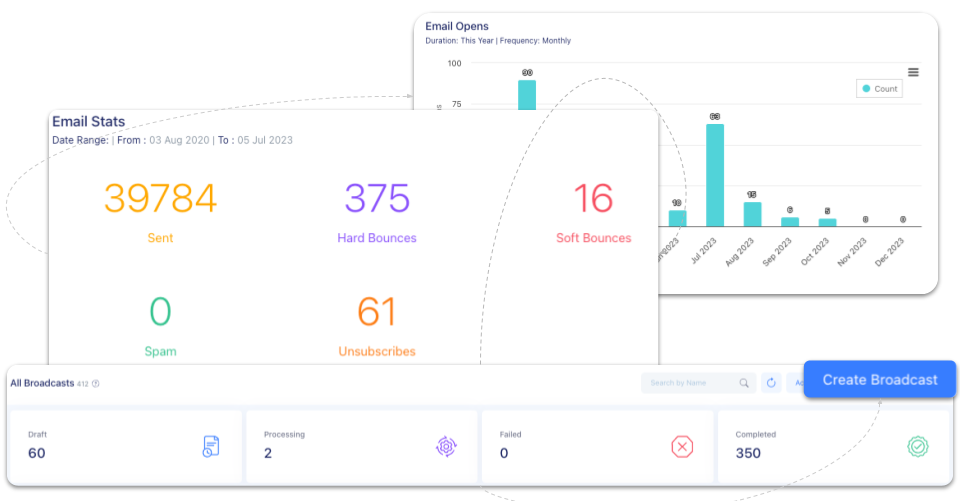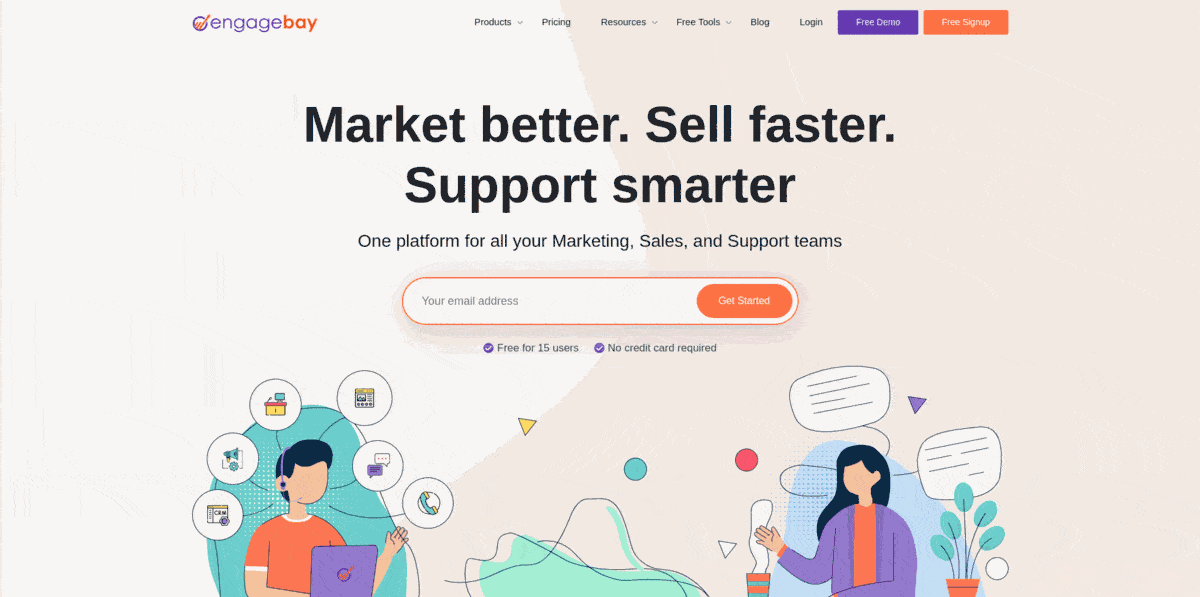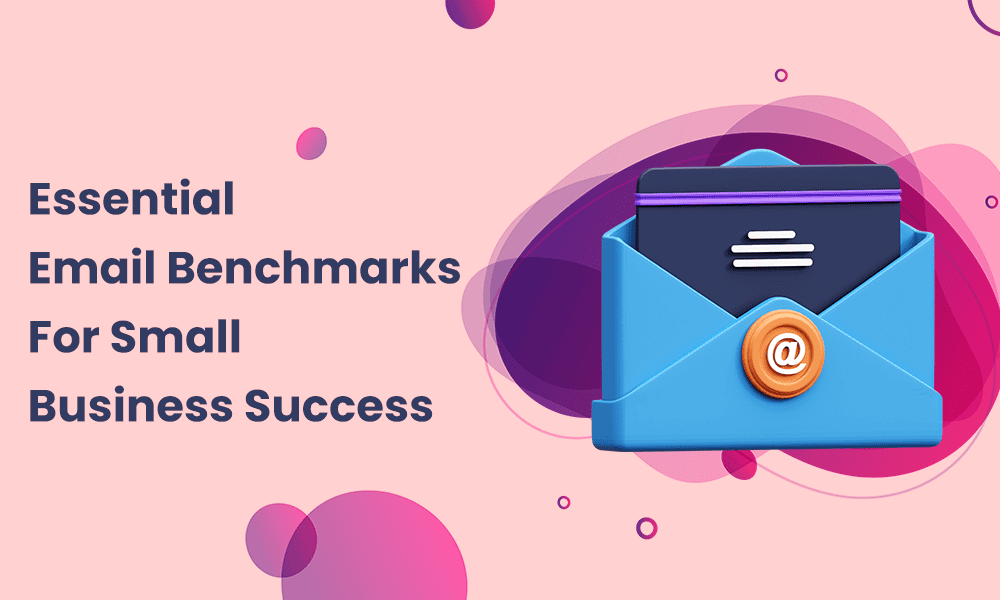Email marketing is ideal for small businesses because of its high return on investment and the low cost of setting up. However, many companies fail at it because they don’t understand essential email benchmarks for measuring success. In this blog post, we discuss the following:
- Email marketing benchmarks
- Email marketing metrics to look out for
- The industry average for different niches
- Tips to improve your email benchmarks
This will equip you with the knowledge you need to run a successful email marketing campaign.
Ready? Let’s dive into it.
Table of Contents
What Are Email Marketing Benchmarks?
Email marketing benchmarks are key performance indicators used to measure the success of an email marketing campaign. Comparing rates, such as open rates, click-through rates, and conversion rates by industry, will give your marketing team an idea of your campaign’s health so you can improve its outcome.
Why Do Email Benchmarks Matter?
Imagine running a race without any standard to gauge your performance; how will you tell if you’re on track or not? You may either judge yourself too harshly because you feel you aren’t doing well or feel too excited about your results while, quite frankly, your results aren’t up to par.
So, email benchmarks set a pace for your email campaigns and allow you to view the health of your campaigns by comparing your results with those of others in your industry. This way, you can make better data-driven decisions about your email marketing strategy. For instance, if a campaign’s open rate falls below the industry average, your marketing team can strategize on tactics to improve open rates.
For example, they can work on changing the subject lines or the email sending times.
Aside from benchmarking against others in your industry, it also makes sense to regularly gauge the success of your email campaigns against past internal results. For instance, based on the success metrics your marketing teams have set, review your stats for a given period, say 30 days, and compare them with previous months’ stats. Then ask questions like the following:
- Has there been improvements over the previous months?
- What strategies have we implemented?
- Which works best based on the results?
- Are there contributing factors to the results of certain campaigns?
- What is our projection for the next 90 days?
- How can we get there?
- Should we continue our past strategy, improve it, or adopt another?
This is important because even though email benchmarks provide you with data on competitors’ email campaigns, they aren’t the most accurate measure of your campaign’s success due to several factors that can cause disparity in results among businesses in the same industry.
Why Do Small Businesses Invest in Email Marketing?
Research has shown that for most businesses, only about 2-5% of all website traffic makes a purchasing decision. Therefore, without an automated lead generation system on your website, a significant portion of the resources employed in driving traffic to your website will be wasted.
So, email marketing helps to nurture these leads generated from your website traffic, delivering personalized marketing material directly to their email.
Email marketing is great for optimizing your sales funnel, generating leads, and nurturing leads across the various sales cycle stages. Additionally, it is more affordable than other digital marketing strategies and has a good ROI. This makes it ideal for small businesses with a limited marketing budget.
Now that we know why email marketing matters to small businesses, let’s look at key email metrics to look for in your emails.
Key Email Marketing Metrics
Below are the most critical email marketing benchmarks to look for to improve your email marketing results.
Open rate
This is the percentage of your total subscribers who open your email. Your email open rate is crucial because it gives you an idea of what kind of emails your subscribers are interested in. However, a great open rate doesn’t necessarily translate into higher conversions. Sometimes, subscribers may open your emails because you use engaging email subject lines.
Most email marketing providers calculate your average open rate automatically. However, here is a formula for calculating your email open rate:
Open rate = Number of subscribers who opened your email / Number of emails delivered successfully x 100

Click through rate
Click-through rate (CTR) is the percentage of email recipients who clicked on one or more links (call-to-action) within your marketing emails. Measuring your average CTR helps you understand the effectiveness of your marketing material and provides valuable insight into your subscriber engagement level.
It also aids in refining your audience segmentation strategies and optimizing your email content, layout, and calls to action to improve engagement and drive better results.
Calculating your average click-through rate is easy; use this formula:
CTR = Number of email recipients who clicked a link within the email / Number of emails delivered x 100
Bounce rate
The email bounce rate is the percentage of emails returned to the sender because they were not delivered to the intended recipient. There are two types of email bounces: hard bounce and soft bounce.
Hard bounce
When an email cannot be delivered due to nonexistent or invalid email addresses, it is called a hard bounce. It could also happen if the email provider blocks the sender’s email address. Businesses may need help with hard bounces since they suggest a serious problem with the email list’s quality, which could damage the sender’s reputation.
Soft bounce
This is a temporary bounce that occurs for one of the following reasons:
- Email recipient mailbox is full
- Email server is down
- Email message is too large
Soft bounces are less damaging than hard bounces because they don’t seriously damage the sender’s reputation.
To calculate your average email bounce rate, divide the number of bounced emails by the number of emails delivered and multiply by 100. For example, if you sent 500 emails and 20 emails bounced back, your bounce rate would be (20/500) x 100 = 4%.
Read more: Bounce Rates and Email Deliverability — A Simple Guide
Unsubscribe rate
The unsubscribe rate is the percentage of email recipients who unsubscribed from your emails within a specific period. It is an excellent index for measuring the relevance of your email messaging to your subscribers. A high unsubscribe rate could mean your content or offers are irrelevant to your target audience.
However, a low unsubscribe rate will help increase the chances of conversions, as only those who find your email relevant are on your mailing list.
To calculate your unsubscribe rate, divide the number of unsubscribers within a specific period by the number of email recipients and multiply by 100.
When you sign up for an excellent email marketing platform, you can automate your sending times and personalize your emails so that the right audience gets the right message when they are most likely to open it.
You also enjoy high deliverability rates, customizable email templates, and in-depth insight into your email performance with its analytics features without calculating them manually.
Industry-Specific Email Benchmarks
Now that we understand the different email marketing metrics, let’s check the different benchmarks by industry. The table below summarizes the open rates, CTRs, bounce rates, and unsubscribe rates across major industries.
| Industry | Average open rate (%) | Average CTR (%) | Average bounce rate (%) | Average unsubscribe rate (%) |
| Architecture | 39.8 | 14.3 | 1.32 | 0.46 |
| Construction | 33.9 | 14.5 | 1.15 | 0.35 |
| Telecommunication | 39.1 | 13.6 | 0.20 | 0.07 |
| Manufacturing | 41.1 | 9.6 | 0.60 | 0.33 |
| Real Estate | 41.6 | 8.7 | 0.31 | 0.21 |
| Education | 35.4 | 8.3 | 0.49 | 0.18 |
| Retail | 40.6 | 7.7 | 0.24 | 0.18 |
| Marketing & Advertising | 38.3 | 7.5 | 0.29 | 0.25 |
| Consulting | 36.9 | 7.4 | 0.44 | 0.30 |
| Online Courses & Coaching | 33.8 | 7.2 | 0.27 | 0.22 |
| Health & Fitness | 41.2 | 6.9 | 0.31 | 0.36 |
| Beauty & Personal Care | 39.9 | 6.9 | 0.35 | 0.41 |
| Information Technology | 33.5 | 6.3 | 0.43 | 0.23 |
| Legal | 39.3 | 6.2 | 0.72 | 0.26 |
| Business & Finance | 36.5 | 5.9 | 0.34 | 0.21 |
| Computers & Electronics | 40.0 | 5.5 | 0.23 | 0.14 |
| Insurance | 39.3 | 5.5 | 0.65 | 0.29 |
| Finance | 41.4 | 4.9 | 0.55 | 0.29 |
| Software & Web Apps | 39.8 | 2.9 | 0.57 | 0.30 |
| Others | 36.3 | 8.7 | 0.34 | 0.27 |
Why do industries have different benchmarks?
Email rate averages vary across sectors for several reasons: business size, audience characteristics, email relevance, purchase cycle length, marketing budget, brand reputation, and product/service complexity.
It’s important to note that different industries have distinct target audiences with varying preferences, behaviors, and purchasing habits. While the target audience in certain sectors may buy products on impulse, some other industries require logical purchases.
For instance, comparing B2B vs B2C marketing reveals differences in their purchase habits, which will pose differences in their respective industry averages.
Additionally, your product’s purchase cycle length can affect your conversion rate. Products requiring a significant investment, such as real estate and complex machinery, typically have a longer purchase cycle rate than retail or entertainment products.
How To Measure and Interpret Your Email Marketing Performance
Measuring and interpreting email benchmarks is crucial for optimizing your email marketing strategy. Here’s a step-by-step guide to track and calculate your benchmarks effectively.
- Define your key metrics: Determine which metrics are most important for your goals, such as open rate, click-through rate (CTR), and unsubscribe rate.
- Set benchmarks: Research industry benchmarks for your key metrics. Use these benchmarks as a reference point for evaluating your performance.
- Track your metrics: Use email marketing tools and analytics platforms to track your email campaigns’ performance. These tools provide data on open rates, CTRs, conversions, and more.
- Compare against available industry benchmarks: Compare your metrics against your industry average to gauge your performance relative to competitors.
- Analyze trends over time: Monitor your performance to identify trends and patterns in your email performance.
- Adjust strategies accordingly: Use insights from your data to refine your email marketing strategies. Experiment with different send times, content types, subject lines, and audience segmentation to improve your campaign performance.
How to Improve Your Email Marketing Performance
We have discussed some key email benchmarks and how these benchmarks serve as a window to understand the health of your email campaigns. Now, let us look at some tips to improve your email marketing.
Define your most important email metrics
First, decide on the email metrics you want to improve. This will determine the next steps you follow. Is there a particular benchmark based on your marketing goals and objectives?
Suppose you want to improve your email open rate. Crafting more engaging subjectSome lines is key. If it’s CTR, then there are several factors to put in place, like send-time optimization, sending emails relevant to your email segments,
Hyper-segment your email list
Next, segment your audience better. Contact segmentation is a critical factor for email marketing success. According to a report from DMA, email marketers experienced a 760% increase in revenue from email segmentation.
You can use several ways to segment your audience: Geography, Psychography, Demography, and Behavior. However, your segmentation method will depend on your industry. If you are an eCommerce seller, for instance, segmenting your audience based on behavior, particularly using the RFM analysis where:
- R stands for recency
- F stands for frequency, and
- M stands for monetary value. You’ll arrive at a much more hyper-segmented list than when you segment based on Geography alone.
Another effective method is to combine segmentation criteria. For instance, after using the RFM analysis, you can segment further by considering the psychographic characteristics of people in each segment. Then, you’ll discover that although some people are similar based on the RFM analysis, they may have different interests and pain points.
A good hack to do this is to gather customer data from your email software analytic tool. You must be signed up for excellent email automation software with advanced CRM analytics. For instance, EngageBay’s email marketing software can segment your clients into various categories using CRM analytics tools, such as age, gender, spending habits, web history, etc., and identify new selling opportunities.

A/B test emails for each segment
Finally, A/B tests different elements of your emails. A trick here is to A/B the campaign for different segments and see what resonates better with your audience in different segments. This may seem overwhelming when you consider doing it manually, which is where EngageBay’s automated A/B testing software comes in.
It helps you get the best results for your email campaigns without the hassle.
Conclusion
So far, we have learned what email marketing benchmarks are, why they are essential to your email marketing strategies, how to measure and interpret them, and how to improve your email performance to match or exceed industry benchmarks.
We have learned that email benchmarks help track the success of an email marketing campaign and that in setting up an email campaign, it is essential to select which of these benchmarks is most relevant to determining its success.
We have also learned that to optimize the results of your email marketing strategy, it is important to regularly measure and analyze these KPIs and compare them to industry averages to gauge your strategy’s strengths and weaknesses and improve accordingly.
Finally, we discussed techniques for improving KPIs, such as segmentation, personalization, and A/B testing, so you can select appropriate email benchmarks, measure and analyze them, and improve your email strategy until it yields the desired results.
To get the most out of your email marketing efforts, also ensure you sign up for an email marketing automation platform with advanced features that allow you to automate your email sends, hyper-segment your audience, and track the effectiveness of your email campaigns by providing in-depth email analytics and reporting.
Frequently Asked Questions
What is a good open rate for email marketing campaigns?
Depending on the industry, a good email open rate should be between 33% and 38%. While understanding these figures is an excellent place to start, it’s also worthwhile to research industry averages and contrast your metrics with those in your particular sector.
How can I improve my email click-through rate?
Craft intriguing subject lines that pique curiosity. Personalize emails with subscriber names and segment your list for targeted content. Ensure your emails are mobile-friendly and prioritize clear calls to action with strong buttons. Finally, test different elements and timings to see what resonates best with your audience.
What does a high unsubscribe rate indicate, and how can I reduce it?
A high unsubscribe rate might mean your messages are landing with the wrong audience, failing to deliver the value subscribers expected, or simply overwhelming their inboxes. To turn things around, consider segmenting your list for targeted content, rethinking your email content to ensure it’s truly engaging, and finding the right frequency to stay connected without becoming a burden.
Are bounce rates important, and what can they tell me about my email list?
Yes, bounce rates are important. Your bounce rate gives you an idea of the health of your email list. A high bounce rate suggests undelivered emails, often due to outdated addresses or typos. This can signal a list needing cleaning or one built through practices that don’t encourage engagement.
Conversely, a healthy bounce rate indicates messages are reaching their intended targets, allowing you to focus on crafting impactful content.
Is there a benchmark for how often I should send emails to my subscribers?
The ideal frequency depends on your audience and content. While studies suggest 2-3 emails weekly might be a peak zone, bombarding inboxes can backfire. Instead, focus on quality over quantity. Aim for valuable, engaging content that resonates with your subscribers.
